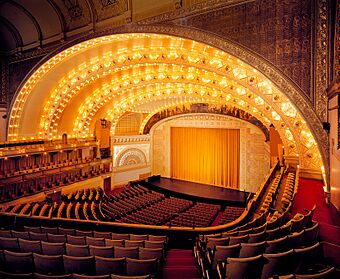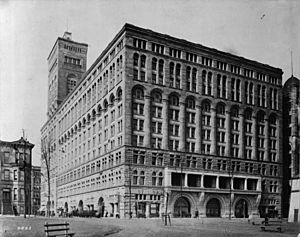Auditorium Theatre facts for kids

interior, photographed in 2017
|
|
| Address | 50 East Ida B. Wells Drive |
|---|---|
| Location | Chicago, Illinois, United States |
| Coordinates | 41°52′34″N 87°37′31″W / 41.8760639°N 87.6251856°W |
| Owner | Roosevelt University |
| Capacity | 3,875 |
| Construction | |
| Opened | December 9, 1889 |
| Renovated | 1967 |
| Architect | Dankmar Adler and Louis Sullivan |
| Tenants | |
| Joffrey Ballet | |
The Auditorium Theatre is a famous place for music and shows in Chicago, Illinois. It is located inside the Auditorium Building at 50 E. Ida B. Wells Drive. The building was designed by Dankmar Adler and Louis Sullivan. It was finished in 1889.
The Chicago Symphony Orchestra played here until 1904. The Chicago Grand Opera Company also performed here for many years. From 1998 until 2020, the Joffrey Ballet called this theater home. Today, the Auditorium Theatre hosts many different concerts, musicals, and events. Roosevelt University has owned the building since the 1940s. An independent non-profit group has managed it since the 1960s.
Contents
History of the Auditorium Theatre
How the Theatre Began
In 1885, a Chicago businessman named Ferdinand Wythe Peck had big plans. He wanted to build a special place for performances. Chicago was still recovering from the 1871 Great Chicago Fire. There were also many worker issues at the time.
Peck wanted to create a modern theater for everyone to enjoy. He also wanted to help Chicago's reputation. To make tickets affordable, he had a clever idea. The building would include a luxury hotel and offices. Money from the hotel and offices would help pay for the shows.
The architects Adler and Sullivan designed the building. It stands at Michigan Avenue and Congress Street. This building is one of their most famous works together.
A Grand Opening Night
The theater opened with a huge party on December 9, 1889. Many important people attended this special event. President Benjamin Harrison and Vice President Levi Morton were there. The Illinois Governor and Chicago Mayor also joined.
Crowds lined the streets to see the famous guests. President Harrison was very impressed by the building. He had visited it before it was finished. Opera star Madame Adelina Patti sang "Home Sweet Home." This was a highlight of the evening.
The Auditorium Theatre helped Chicago get chosen to host the 1893 World's Columbian Exposition. The theater's grand opening showed that Chicago could handle a big event. It proved the city had vision and money for a world-class fair.
Famous Performers and Events
In its early years, many famous entertainers performed here. These included John Philip Sousa and Sarah Bernhardt. The Ziegfeld Follies and Anna Pavlova also graced the stage. Important political figures like Theodore Roosevelt visited.
In 1912, Theodore Roosevelt gave a famous speech here. He said he felt "as strong as a bull moose." This was during his campaign for president. The theater was also home to the Chicago Symphony Orchestra. Indoor baseball games were even played on its stage.
Challenges and Closing
Mr. Peck hoped the hotel and offices would always support the theater. But this plan did not work forever. Newer hotels with private bathrooms became more popular. The Chicago Symphony Orchestra moved in 1904. The Grand Opera moved in 1929.
In the early 1930s, people thought about tearing down the building. But it cost too much to demolish it. The theater went bankrupt and closed in 1941.
In 1942, the City of Chicago took over the Auditorium. It became a center for soldiers during World War II. The stage was turned into a bowling alley. Much of the beautiful decorations were covered up. Over 2.2 million servicemen used the building between 1941 and 1945.
Bringing the Theatre Back to Life
In 1946, Roosevelt University bought the building. This saved it from being torn down. But the university did not have money to fix the theater. So, it stayed closed for 20 years.
In 1963, Mrs. Beatrice Spachner started a group called the Auditorium Theatre Council. She worked to restore the theater. Her group raised almost $3 million for renovations. Architect Harry Weese led the repair work.
On October 31, 1967, the Auditorium Theatre reopened. The New York City Ballet performed "A Midsummer Night's Dream." It was a grand reopening event.
Music, Dance, and Shows
Many famous musicians have performed at the theater. French organist Alexandre Guilmant played in 1893. Russian pianist Sergei Prokofiev performed in 1921.
Since its reopening, many rock and pop stars have played here. These include Ray Charles, The Beach Boys, and The Doors. Other famous names are Jimi Hendrix, The Who, Janis Joplin, and David Bowie. Bruce Springsteen, Elton John, and Queen also performed.
Many dance companies have graced the stage. These include Alvin Ailey American Dance Theater and Bolshoi Ballet. Popular Broadway musicals have also had long runs here. Some of these include The Phantom of the Opera and Les Misérables.
On July 5, 1970, Crosby, Stills, Nash & Young performed. Part of their concert was recorded for their live album 4 Way Street.
The Auditorium Theatre Today

Today, the Auditorium Theatre continues to care for its historic building. They have added the theater's first public elevator. They also have a new studio in the Roosevelt University Wabash Building.
Each year, over 200 performances and events take place here. These include dance, theater, and music. More than a quarter of a million people visit annually. The theater offers many international and local shows.
One special program is "Hearts to Art." This summer camp uses music, theater, and dance. It helps children who have lost a parent. The camp helps kids gain confidence and express themselves. They connect with other campers and caring adults.
In 2014, it was announced that the 2015 NFL draft would be held here. This was the first time the draft was outside New York City in 50 years. The first round took place on April 30, 2015. The theater also hosted the NFL Draft again in 2016.
The Joffrey Ballet performed at the Auditorium from 1998 through 2019. The ballet company moved to the Civic Opera House in 2021.
Amazing Architecture and Design
The Auditorium Theatre had many advanced features for its time. It had 3,500 bare light bulbs, which were very new in 1879. The sound quality was excellent. It also had air conditioning, which used 15 tons of ice daily.
The stage had 26 hydraulic lifts. These could easily raise and lower parts of the stage. There was also a huge 95-foot space above the stage for scenery.
Louis Sullivan wanted the theater to be fair for everyone. The best seats were not just for the richest people. The box seats were moved to the sides. The main floor and balconies offered great views for all visitors.
The decorations showed natural elements like flowers and vines. They did not copy old palaces. The theater also used a design trick called "compression and expansion." Visitors walked through a small, dark entrance. This made the huge, six-story auditorium feel even more dramatic when they entered. The grand arches and glittering ceiling created a stunning effect.





